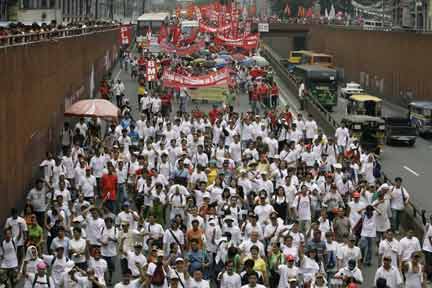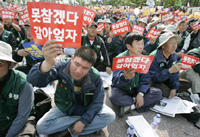International workers' day - explainer
What is May Day?
by Tony Cross
Article published on the 2009-05-01 Latest update 2009-05-01 10:57 TU
The idea of a workers' holiday first surfaced in Australia in 1856 but it was not until 1898 that the Socialist International, founded by Karl Marx along with other socialists and anarchists, declared 1 May international workers' day.
The day was picked to commemorate events that followed the Haymarket massacre in Chicago, Illinois, in 1886.
During the course of a three-day general strike throughout the United States starting 1 May of that year, in support of the eight-hour day, police killed three employees of the McCormick Harvesting Machine Co. At a subsequent protest rally on 4 May, a bomb exploded and police attacked the crowd. By the end of the day at least 12 people, including seven police officers, were dead.
Seven anarchists were later hanged for the bombing and another committed suicide before the execution. There were international protests about the trial, with criticism that the jury was made up of business leaders and that five of the accused were not present when the explosion took place.
The eight-hour day became one of the key demands of May Day demonstrations. They were held with or without the authorities' permission and spread around the world as the socialist movement grew in the late 19th and early 20th centuries.
The end of World War I and the Russian revolution saw a split in the socialist international, with the formation of the Communist International, which accused its predecessor of reformism and turning its back on internationalism.
May Day continued to be celebrated by member parties of both internationals, along with trade unionists and what remained of the anarchist movement, but with more enthusiasm on the left of the labour movement than on its right.
In the Soviet Union the day became a holiday, with parades which became increasing dominated by official declarations and displays of military strength. This example was copied in post-World War II eastern Europe and China.
In 1958, at the height of the Cold War, the US Congress, which had previously banned political parties from having international affiliations, declared 1 May Loyalty Day.
In 1977, suspected right-wing snipers fired on May Day demonstrators in Istanbul, Turkey, killing 34 people. Following a military coup in 1980 a public holiday on the day was abolished and was only reinstated on 29 April 2009.
In 2009, the left, on the ideological retreat since the fall of the Berlin Wall in November 1989, is hoping that the world economic crisis will put a question mark over free-market capitalism and lead to massive turnouts on May Day demonstrations.
International workers' day - photo report
French unions fail to reach demo target, clashes and protests in Americas
2009-05-02 10:06 TU
Listen
Related subects












